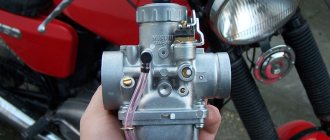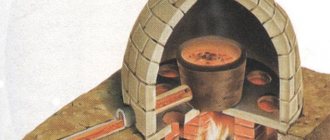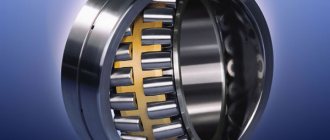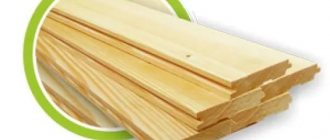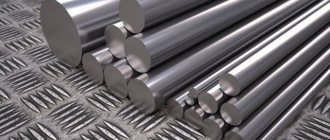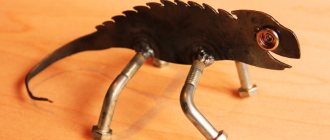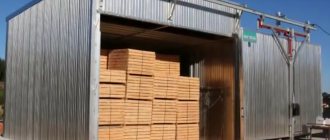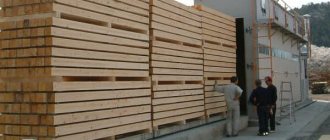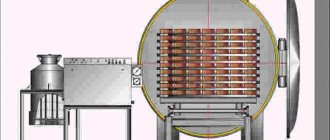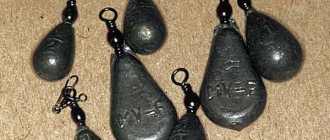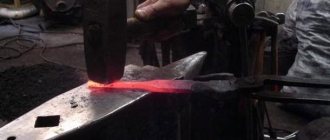What metal are bullets made from?
And again, good day to everyone reading. Mentions regularly appear here regarding pneumatic ammunition, but there has not yet been a place for people to park, a point of possible discussion.
In addition, stores are full of all kinds of bullets, and it can be simply difficult for beginners to navigate such “trash.”
Let's try to streamline the topic a little and talk in general terms about bullets for air guns.
Let's agree a little on the names. Here and further we will call everything bullets: both rifle bullets and air pistol balls, so if something like this flashes somewhere, we close our eyes.
In addition, some people do not like to call pneumatic bullets “bullets”, preferring a softer name like “bullets”.
By the way, abroad the word “bullets” is used for firearms ammunition, and “pellets” for pneumatic ammunition.
General typology
Before diving into the world of bullets, the shortest important classification of pneumatics for this matter is: pneumatics with a smooth barrel and with a rifled barrel. Rifles, by definition, come with a rifled barrel; pistols come with both rifled and smooth barrels.
Typical representatives of air pistols firing lead bullets: MP-651, A-3000 "Skif", IZH-53M, Umarex Beretta 92S and Walther CP88, as well as revolvers like Gletcher SW R25.
That’s all for now, we already have a whole article here about types of barrels and examples of weapons.
Pneumatic bullets are made of lead or steel. Lead bullets are used for rifled barrels, steel bullets for smooth ones. Steel ones are made in the form of a ball (BB), lead ones are usually in the form of a familiar shooting range bullet with a head and a “skirt”.
In flight, rifle bullets are stable, the head is heavier than the skirt, and the rifling sets the spin. They have low friction in the barrel (touching occurs only with the edge of the head and skirt).
For shooting at near and supersonic speeds, it is recommended to use bullets with an ogival shape, where the laws of aerodynamics already remove a regular bullet from a state of stability.
To maintain their shape, but for use in more powerful samples, bullets are increased in weight by increasing the caliber, while maintaining stability and high muzzle energy.
The most popular pneumatic caliber is 4.5 mm (.177). Hunting samples use the mentioned increase in caliber - 5.5 mm (.22) and 6.35 mm (.25). In factory production, bullets up to a caliber of 12.7 mm (.
50), in practice there are even more homemade ones. Ideally, bullets are selected individually in batches for a specific barrel.
For fans of precision fitting, some manufacturers even assign a skirt diameter to their bullets (for example, 4.50 mm, 4.52 mm).
The mass for bullets is indicated in grams. The USA and some Western countries like to use grains to measure it. 1 gram – 0.062 grains. The vast majority of pneumatic bullets up to 7.5 J fall within the range of up to 0.55 g.
Here it is worth understanding that weak pneumatics are not capable of accelerating a heavy bullet to a speed that ensures its stability and effective energy transfer. A light bullet, on the contrary, will quickly lose energy, not providing stability at a distance.
So selecting the bullet weight for an air gun is also an individual matter.
Classification by shape
It is clear that bullets can have a wide variety of shapes, but here we will try to clearly structure them according to general characteristics and give a description of their application.
Flat bullets
Typical of the sports shooting world, they leave precise round holes in the paper. Within acceptable hardball speeds, the risk of penetration in humans is minimized. Due to the high resistance created by the shape, they behave well only at short distances.
Hemispherical bullets
The most popular airgun bullets for long-range shooting. Almost all samples have high ballistic coefficients.
Conical bullets
They have good penetrating ability. But the accuracy of shooting from such bullets may suffer, because making the center of the cone ideal is technically difficult.
Expansive bullets
Or unfolding bullets. Bullets with a depression in the head. When hitting a target, they turn sideways, thereby delivering a blow over a larger area, creating a greater defeat. Used for hunting.
In practice, it can only be used at close range due to the need for high speed. Ballistic performance is slightly higher than flat bullets.
There are models with a plastic core, which supposedly creates better “flight” characteristics.
How cartridges are made
How cartridges are made
May 15 '16
In Lonoke County, Arkansas, there is a Remington plant that produces ammunition that is supplied to many countries around the world. It is the company's only ammunition plant, but has enough capacity to meet the demand for Remington ammunition in the United States and beyond.
On an area of 485 hectares there are production workshops, living quarters, a canteen, a hospital, other buildings (in total there are 46 buildings on the territory of the plant with a total area of 70,000 sq. m), as well as a shooting range and hunting grounds inhabited by wild animals. The plant was built in 1969 and has been in operation since 1970. Since the nearest city is more than 30 km away, all the necessary infrastructure for work, accommodation and food for staff has been created on the territory of the enterprise. Today, the plant employs 1,257 employees, in some of the workshops work goes on around the clock. In a year, Remington produces 2.6 billion rounds of ammunition and 100 million units of reloading products (cases, bullets, etc.), while consuming 20,000 tons of lead and 5,500 tons of copper.
Phil White, editor of the gun blog thefirearmblog.com, visited the Remington ammunition plant and described the production process for popular types of ammunition.
Satellite view of the plant
When the existing capacity is not enough, a new workshop appears on the territory of the plant
Lead enters the plant in this form.
It is then rolled into cylinders and sent to the production line
Lead in cylinders passes through special machines, where it takes the form of wire
Bullet blanks are cut and stamped from wire. In the photo - a lead bullet for a pistol cartridge
Copper arrives at the plant in the form of coils and is cut into sheets. The photo shows a copper sheet after stamping
This is what the blanks from which lead bullet shells will be made look like
This is what a blank for a .303 cartridge case looks like
In this device, the sleeve is fired to further give it the desired shape.
Giving the sleeve its final shape. The mechanisms work so quickly that the process looks blurry in the photo.
Next, install a primer in the case, add gunpowder and insert a bullet
Finished cartridges move along a transport belt to packaging
Packed cartridges ready to go to the store
Robotic «
hand
"
loads boxes of ammunition onto pallets
The production process for pistol cartridges is somewhat different from the production of rifle cartridges. The machine produces cartridges in special dies
Cases and bullets are fed into the machine, from which finished cartridges are obtained.
Loading workpieces into the machine
Ready cartridges at the exit
This is how they produce shot for smoothbore cartridges
Molten lead is fed onto a special sieve, and then drops of lead fall from a great height into the water, “along the way” acquiring a perfectly round shape
Shot sorting machine. Non-ideal pellets are rejected and sent back to smelting
Shot of various sizes is stored in huge tanks
This piece of plastic will be used to make cartridges for smoothbore shotguns.
Plastic blanks are heated and drawn into tubes of the required diameter.
Brass blanks from which the case bottoms will be made
The plastic tube is cut, connected to the bottom, after which a primer is inserted into the finished cartridge case, gunpowder is poured in, and a wad container with shot is inserted. One machine is responsible for all these processes
Several rounds from each batch are tested using this shotgun replacement device.
"Fresh" cartridges can be tested at the factory shooting range
Airgun bullets: overview of the main types
And again, good day to everyone reading. Mentions regularly appear here regarding pneumatic ammunition, but there has not yet been a place for people to park, a point of possible discussion.
In addition, stores are full of all kinds of bullets, and it can be simply difficult for beginners to navigate such “trash.”
Let's try to streamline the topic a little and talk in general terms about bullets for air guns.
Let's agree a little on the names. Here and further we will call everything bullets: both rifle bullets and air pistol balls, so if something like this flashes somewhere, we close our eyes.
In addition, some people do not like to call pneumatic bullets “bullets”, preferring a softer name like “bullets”.
By the way, abroad the word “bullets” is used for firearms ammunition, and “pellets” for pneumatic ammunition.
Ogival bullets
The shape resembles samples from firearms. Show excellent performance when firing at near or supersonic speeds. They require a powerful rifle for confident acceleration.
Spherical bullets
They are balls, they are BB. One of the most common types of air pistol bullets, used for most CO2 smoothbore air guns. BB is named after the average size of the shot (B, BB, BBB).
“BeBeshki” are made mainly of steel, with copper, zinc or other anti-corrosion coating. The balls are light (about 0.3 g), and they are still “balls”, so we can generally remain silent about any aerodynamic properties. But at close range they are excellent for destroying glass containers, because... Steel still copes with this task more confidently than lead.
The BB caliber is slightly smaller than the barrel - usually around 4.4 or 4.45 mm. The material of the balls for an air pistol does not allow shooting along rifling, because... The barrel will wear out quickly. For rifled barrels there is an option for Gamo Round lead balls (4.4, 4.45), but the model is not suitable for all samples.
Stun bullets
The plastic base contains an explosive charge. When they hit a target they detonate and explode. For example, domestic “Blik” bullets belong to this class. It is better not to fill high-velocity rifles; the plastic may not withstand it.
Armor-piercing bullets
A harder metal, such as a steel ball, is used as the core. Needed for the destruction of cans, bottles, and barrels for entertainment purposes that have resisted crushing lead.
Cap bullets
Lightweight bullets (there were options up to 0.2 g) of different classes, an excellent way to bring a powerful rifle to supersonic for the feeling of a barrier. The rest is not so great.
Dart bullets
Several options for plastic elongated bullets with a sharpened metal tip. Used to defeat something or someone.
Well, we’ve looked at the basic classification of all currently existing bullets for air guns. Price ranges and quality can vary greatly from manufacturer to manufacturer. The main thing in this matter is initial individual selection and experience. Proper selection will ensure not only an increase in the shooting performance of the weapon, but also its longer life.
Subscribe to our news Share interesting material with friends
Types of bullets for smoothbore cartridges
03.11.2020
Now on store shelves there is a large assortment of various ammunition for smooth-bore weapons. It is very difficult to get confused and choose the right one. We have collected for you the most popular and effective types of bullets and tried to help you choose the right option.
Bullets are:
Sub-caliber are bullets with a diameter less than the diameter of the bore. They can be used with choke constrictions, do not injure the barrel when passing through and, as a rule, are equipped with a seal container. Due to their reduced size, they have a greater initial speed and flight distance. But the destructive power is noticeably less than that of a caliber one.
Caliber bullets are bullets with a diameter almost equal to the diameter of the bore. As they pass, they deform themselves and can cause damage to the trunk. They have great lethality, but cannot be used with PSCs.
Sub-caliber bullets
Sub-caliber bullet. Created in the 80s in the USSR. It has many modifications suitable for different conditions. It is a lead projectile mounted on a plastic shank.
Has good accuracy at long distances. But there should be no obstacles on the way, since bushes and thickets, even with slight contact, strongly deflect the bullet.
Object of hunting: elk, wild boar, bear.
Distance: up to 150 m.
Weight: 33 gr.
This is a sub-caliber bullet, made of steel, and does not deform when it hits the target. It has an aerodynamic shape, which is repeated by the container. Provides good combat accuracy. Effective under any shooting conditions, even in bushes or reeds.
Object of the hunt: a large animal that can withstand a wound - a bear, a wolf, an elk.
Distance: 75-100 m.
Weight: 28 gr.
. Spherical sub-caliber bullet. It is used for training in shooting with bullet cartridges, training and amateur shooting, as well as for hunting in open areas at short distances, except for round-up hunts. Compatible with any choke.
Object of hunting: sports and training shooting.
Distance: up to 70 m.
Weight: 27 gr.
. This is a sub-caliber bullet, which is made in the form of a ball with intersecting belts. It is light in weight, which does not allow it to develop a high initial speed and degree of damage. The disadvantage is the tendency to ricochet.
Hunting object:
Distance: up to 80 m.
Weight: 30 gr.
. Sub-caliber bullet. It consists of a polyethylene body and a striking element in the form of a steel cylinder. There are guide ribs on the body. Shooting through obstacles is not advisable. It has a fairly high initial speed of up to 400 m/s and has high stopping power. It does not deform when fired and hits the target. Can be used with any choke.
Object of hunting: elk, bear, wild boar.
Distance: up to 100 m.
Weight: 31 gr.
. Or Shituev's bullet. Externally similar to an aircraft bomb. Developed in 1989 by the Krasnozavodsk Chemical Plant. It has high lethal characteristics and is effective when shooting in open space. If there are obstacles, ricochet may occur.
Object of hunting: elk, wild boar, deer.
Distance: up to 100 m.
Weight: 29 gr.
Caliber bullets
A caliber bullet consisting of a head part with a recess for attaching a stabilizer and a shank. The bullet weight is 43 grams and is designed for Magnum high-pressure barrels.
Can be used with a full choke. Due to its large weight, it has increased energy of destruction and a high stopping effect.
Can be used at short distances, regardless of the presence of obstacles in the form of thickets.
Object of hunting: elk, bear, deer, wild boar.
Distance: up to 50 m.
Weight: 43 gr.
. It has the shape of a truncated cone with an elongated stepped head and a stabilizing belt, from which guide ribs extend. The bullet has a high lethal effect and good stopping power at medium distances.
Object of hunting: deer, roe deer, wild boar, elk.
Distance: up to 50 m.
Weight: 32 gr.
It was developed more than 150 years ago for pneumatics, but due to its excellent ballistic characteristics, it began to be used for smooth-bore weapons. When fired, it does not lose its shape and has high stopping power, combat accuracy and is suitable for shooting using choke constrictions.
Object of hunting: wild boar, elk, deer.
Distance: 75-100 m.
Weight: 32 gr.
. Caliber bullet. It has longitudinal guide ribs that ensure precise alignment in the barrel bore. When passing through the PSC, they do not collapse and do not pose a danger to the barrel.
When it hits a target, the expansive recess in the head expands the bullet to a diameter of 35-40 mm.
It has a high stopping effect and is designed for use with choke constrictions up to 1 mm.
Object of hunting: wild boar, elk, deer.
Distance: up to 50 m.
Weight: 28/32 gr.
. Caliber compound bullet. It has a striking element made of lead, twelve guide ribs and a leading belt in the lower part. The stabilizer is made in the form of two truncated cones with a through hole into which the seal is placed. It performs well when shooting in thickets at medium distances.
Object of hunting: roe deer, deer, as well as sport shooting.
Distance: 50-75 m.
Weight: 28/32 gr.
Bullets for use with Paradox drill bits
The advantage of such ammunition is that they have ribs on the body that slide along the rifling of the barrel and thereby acquire additional rotation. This provides a good stopping effect comparable to rifled weapons.
MAKING BULLETS
MAKING BULLETS
I don't make my own bullets, so I asked Bart Sauter of Bart's Custom Bullets to take some photos of the process to include in the book.
Many benchrest shooters compete and win with bullets they make themselves, so if you have the time and inclination to do so, the following illustrated story will get you in the right direction. To make a bullet, two elements are required: a copper jacket and a lead core. Of course, there is an initial investment of money in presses, dies, tumbling drums, lubricants, trays, micrometers, etc., but the bullet itself is, in theory, a fairly simple component. Making bullets is selfless work. To turn a copper shell with a lead core into a projectile capable of winning accuracy requires a lot of operations. This process requires more “art” and “soul”. These are things that cannot be described, they come with many years of experience.
It all starts by cutting lead wire from a 50-pound spool into 18-inch strips. This wire is either pure lead or has 1% or less antimony, and has a diameter of .187?.
Each wire is then rolled between two pieces of wood so that the curvature caused by the winding is removed. They do not have to be very precise, as the goal here is to make the wire straight enough to fit into the core cutter tube so that it can be cut into pieces 2.5 grains larger than required.
There are many types of core cutters. The function of a core cutter is to cut the lead wire into imperfect cylinders, slightly larger than required to make the bullet core. The left photo (above) shows a hand cutter. The lead wire is fed into a cavity adjusted to the desired core length. The handle turns and the core is cut off.
The picture above on the right shows an electric cutter that works in a similar way. The operator simply threads the wire into the tube, and the machine cuts a piece of it to the desired length. There are also large machines that can feed 50-pound rolls of lead and cut that roll into thousands of cores in one smooth, quick operation.
The rough cores then need to be lubricated so that they can be "extruded" into the precision shape and size we need.
Photo of a tumbling device in which 4,000 cores are lubricated.
The lubrication operation is carried out using a tumbling device and a measured amount of castor oil (or similar lubricant). Approximately 2000 cores are placed in each jar, where they are tumbled for 5 minutes. This process leaves a thin film of lubricant on each core and they are now ready for crimping (extrusion).
Lead is a dead metal. Under pressure, it takes the shape of a matrix made exactly to the required diameter. Excess material is squeezed out through the cavities so that exactly the required weight is achieved. For a typical 68 grain bullet, the desired lead core weight will be approximately 45 grains. For this operation, a good, powerful and precisely made press is used. When the core is molded, it falls out of the die onto a ramp and is fed into the collection area. Weight and uniformity of diameter and length must be checked frequently. Visual inspections are also performed using a high-powered magnifying glass to determine if there are any pits or scratches on the cores.
Finished cores still have a thin film of lubricant on them, so they must be degreased before being seated in the shells. After degreasing, you can begin to work on the shells.
J4 shells are supplied in buckets of 1800 pieces. Quality checks must be performed to ensure they are uniform in wall thickness, usually within a tolerance of .0003? or less. This measure ensures that the longitudinal center of mass of the finished bullet will be located very close to the center of rotation, helping the bullet have stability close to its ideal value.
The outside of the shells are coated with a 50/50 mixture of Bag Balm and Vaseline and tucked into trays. The amount of lubricant and the time to tumbling the casings to achieve a thin film of the correct thickness depend on the number of casings and the tumbling method. It takes a little experimenting to find the right ones.
The insertion of cores into shells must be done on a precision press with an equally precise die/punch combination. This matrix must be extremely uniform in diameter so that the seated shell (extruded to the final diameter) expands to uniformly fill all the gaps between it and the internal surfaces of the shell.
The punch should not rub against the casing, but should fit very tightly into the casing so that a minimum amount of lead is forced around it. Carbide is the best material for these dies. The extreme hardness of carbide guarantees a long service life (more than 1,000,000 bullets). The punches are made from hardened steel, and an assortment of punches is also required to match the specific batch of casings.
Punches are made from steel for economic and practical reasons. Steel punches are cheaper than carbide ones, and in addition, the steel will break if, by chance, the punch comes into contact with the carbide matrix.
Once the cores are seated, they are sent back to the tumbling machine to be coated evenly with lubricant for the tip making operation.
The sharpening press forms the outline of the bullet's nose. Extreme care must be taken to ensure that the bullet being extruded from the die does not hit anything hard. The bullet's pressure ring is the most critical part of the bullet, and small nicks or scratches will destabilize the bullet as it leaves the muzzle. During the pointing operation, samples are carefully measured to ensure that all bullets meet the finishing size specifications.
Finally, the bullets are degreased and inspected again before packaging. Samples are set aside for quality control and periodic range testing. When bullet weights are so uniform, precision scales can be used to ensure that the exact number of bullets is loaded into the boxes.
It takes a huge amount of work and experimentation to get the bullets to fire accurately. Die making, lubrication, core seating pressure and sharpening operations are all extremely important. Without trial and error, plus trips to the range to ensure every job is done perfectly, the great bullets we shoot so freely wouldn't exist.
Making bullets is a lot of work. The next time you write a check to a bullet maker, imagine the real cost of that labor. And be glad that they want so little for him!
What are machine gun bullets made from?
What and how are bullets for rifled weapons made from? Currently, the industry produces a very large number of various types of ammunition.
If previously almost all cartridges were made as carbon copies and had a very simple design, today the technologies for the production of small arms and cartridges have gone far ahead.
Without exaggeration, we can say that the most talented designers and inventors are attracted to work in the military-industrial complex, and their activities are very well financed, which, of course, bears fruit.
A little history
The prototype of the bullet was an ordinary stone. Some may be surprised, but this is true. It was with this “projectile” that ancient people killed wild animals to get their own food. Only after many, many millennia, an unknown inventor figured out how to increase the killing power of the stone.
People began to use the sling. The stone, which was spun on a leather belt, flew at a much higher speed than the stone that was thrown by hand. What were bullets made of in those days? There was no weapons production as such yet.
“Bullets” (aka stones) were collected from the surface of the earth and put into action.
It was only in the tenth century AD that firearms appeared. Its homeland is Ancient China, where the bullet in our usual sense was first used. What was the weapon itself made of? The inventor used bamboo as a trunk - a fairly durable material.
According to some reports, bamboo can withstand ten times the load when tensile tested than ordinary quality steel. Many people are also interested in what bullets were made of at that time. Surprisingly, in those days bullets were cast from lead. This material, like many others (for example, antimony, tin) has been known to mankind since ancient times.
And ancient people appreciated the properties of lead, namely its low melting point.
Small arms have undergone significant evolution. In April 2013, an event occurred in Russia that resonated throughout the world and marked a new milestone in the development of weapons production technologies. We are talking about a statement by representatives of the Ministry of Defense about the abandonment of lead tracer bullets and the transition to the use of armor-piercing projectiles with a steel tip.
Minie bullet
A French citizen, Captain Minier became famous throughout the world for his invention back in 1848. In those days, people already had an idea about rifled weapons, but they were not widely popular.
The main reason for this was problems with loading: in order to impart rotation to the bullet as it moves along the barrel, one very important condition must be met - the bullet must fit snugly against the inner spiral wall.
How did the captain solve this problem? What did he make the bullets from? Everything ingenious is simple. Minier proposed an original way to solve the problem: install a steel core on the back of the lead bullet. When the gunpowder was detonated by a shock wave, the core was driven into the lead tip, which led to an increase in its diameter to the dimensions necessary to produce a high-quality shot.
The appearance of a cartridge with a sleeve
A little more time passed, and the Minier bullet was replaced by a cartridge with a cartridge case. What were the bullets and casings made from? The damaging element itself was still (and remains in many cases today) made of the usual lead. A variety of materials could be used to make the cartridge case. Thanks to this invention, it became possible to load weapons not from the muzzle, but from the breech.
Chuck design elements
In combat and hunting weapons, so-called unitary cartridges are used. A mandatory attribute of such a projectile is a metal casing. It combines all the constituent elements into a cartridge: the primer, the charge (gunpowder) and the bullet itself.
What are the sleeves made of? The main material for the production of live ammunition is brass. Hunting cartridges can be used many times; such products are made of plastic (walls) and brass (capsule). But hunters often use shot rather than bullets.
The device of an ordinary bullet
The bullet is the main and most important component of the weapon. It is she who is the damaging element. The entire variety of cartridges can be divided into two classes: cartridges with an ordinary bullet and cartridges with bullets of a special design and purpose.
What material are bullets made from? Their device is actually not as simple as it might seem at first glance. We say with confidence that a modern bullet is a masterpiece of engineering.
Ordinary bullets (for hitting open targets and unprotected enemy forces) consist of the following elements: jacket, core and jacket. The material used in most cases is lead, although there are alternative materials that can replace lead.
What is the function of the bullet core for a machine gun? What is it made of? The answer is simple: the core is introduced into the design to increase the penetrating power of the ammunition, and the material is steel with great hardness.
Device of special bullets
Special-purpose ammunition is usually divided into bullets of a single and combined principle of action. The first include tracer, incendiary, explosive, armor-piercing and other bullets. However, at present, preference is given to dual-use ammunition: armor-piercing tracer, armor-piercing incendiary and others.
Bullets of this class can be used in a wide variety of weapons, from an anti-aircraft gun to a Kalashnikov assault rifle. What are bullets made of for special tasks? The design of such cartridges is more complex compared to conventional ammunition.
Thus, a bullet for tracer fire, in addition to a steel core and jacket, has a tracer, thanks to which the bullet’s flight path is visible in the dark. Incendiaries contain a substance that ignites when a bullet hits a gap as a result of compression of the cavity and heating.
How and what are pneumatic bullets made from?
The material used for air gun bullets is regular lead. It is this material that allows for optimal performance, as it is heavy and easily deformed.
But with production technology, everything is not as simple as it seems. Bullets for air guns can be produced by casting, cold stamping, and rolling. Each of them has its own advantages and disadvantages.
Such bullets are subject to very stringent quality requirements. In accordance with international standards, bullets from the same batch should not have a difference in weight of more than 0.005 grams. Achieving such precision is quite difficult, given the small size of the product and the fast pace of production.
Her Highness Bullet
Yesterday we were talking about cartridges, and today we have the next element - the bullet. Perhaps no other cartridge component gives rise to so many myths, legends and outright tales. They can be heard in the stories of servicemen, and in the retelling of these stories through third parties, and even from the lips of those who themselves did not hold weapons in their hands, but a friend of his father-in-law told him about it, and he is a serious man, an ensign of the pipeline troops: he’s the type to lie will not be. So stories arise, either about terrible explosive bullets, or even more terrible ones - with a displaced center of gravity, or about absolutely terrible atomic bullets (well, I won’t even consider this dream of reason). Let’s go over the bullets today.
Steel core and brass shell at different stages of production
As with the cartridges, here, too, everything followed the path of complication - first a lead ball, then a lead bullet of a more complex shape, and then it came to the shell. Yes, exactly to the one that is all-metal, which gave the name to Kubrick’s famous film. It became necessary due to the increase in speeds - lead normally maintains speeds of about 450 m/s, and then even the hard antimony alloy begins to flatten and actively spread on the rifling, which has a very bad effect on shooting accuracy. Therefore, they began to place the lead core in a thin jacket made of a more durable material. At first, cupronickel was the most popular, then it was replaced by cheaper brass options, in particular tombak. This made it possible to fully realize the capabilities of smokeless powders and increase speeds to 700 m/s or more. This has dramatically complicated production: simply taking bullets and pouring them into molds will no longer work, as was previously the case with lead. Moreover, casting as such in large enterprises has largely been replaced by stamping. Wire is drawn from lead, it is cut into pieces of equal length, and bullet cores are already stamped from them. This is much more technologically advanced than casting, which is also highly desirable to produce under pressure in order to avoid defects. The technology for producing a shirt is similar to making a sleeve; it is also drawn from a blank. In addition to the already mentioned brass and tombac, steel is also used here. Of course, most often in the form of a bimetal, because steel on steel at high speeds is like shooting files; no chrome-plated barrel can withstand such abuse. Although the Germans from RWS also have pure steel hunting bullets TUG and TIG, this is rather an exception. In general, the shape of the bullet is noticeably simpler than the cartridge case, so many more manufacturers are taking advantage of the cheaper bimetal here than with cartridge cases. Next, the components are combined - the core is pressed into the shell and the bullet is given its final shape. Continuous press work. As you can see, even a simple jacketed bullet of 7.62 mm caliber cannot be made at a pasta-cigarette factory, and we are not at the beginning of the twentieth century; simple jacketed lead is not suitable for military purposes.
Different types of bullets in cross-section using the example of 7.62x54
People, you see, didn’t like the fact that they were being killed just like that with these bullets, so they started making various protective pieces of hardware from durable types of steel. They attached wheels to some of the pieces of iron, and to some of them caterpillars, and to some of them they attached straps like a bra, and in general they began to carry them around, complete with all sorts of bowler hats on their heads. In general, armor must be penetrated, but lead does this poorly, it is soft and simply splashes on it. Or it leaves dents of varying depths, depending on the mass and speed of the bullet, but still does not penetrate. Replacing soft lead with hard steel is also not an option - it is light, and the bullet needs mass, otherwise it will quickly lose speed. The solution was found in the form of a core made of a combination of two elements, usually steel and lead. One of the options is that the front part of the core is steel, for breaking through obstacles, the back part is lead, for mass. In another version, the steel core is placed in a lead jacket, and then it’s all in the shell. Such a bullet already flies far and penetrates well. It turns out to be long, because steel is still light, but these are minor things. The only thing is that this bullet is demanding on the quality of workmanship, because if there are two elements it is very easy to get an imbalance, which has a bad effect on accuracy. Because of this, bulk cartridges with a steel core are usually inferior to match or hunting bullets without one, but for combined arms combat their capabilities are quite sufficient. By the way, the bimetallic shell also makes a similar contribution - the uneven thickness of different coating layers has an effect.
A core made of ordinary steel allows you to pierce sheets of ordinary steel or thin armor, which is not always enough. But if you replace it with carbide, then you can already use quite decent armor plates, like plates of good body armor or the sides of armored personnel carriers. The bullet, accordingly, will be armor-piercing. In terms of design, there are most often no special differences, but they are much more expensive: the price of a core made of high-carbon steel or tungsten carbide plus the greater complexity of its processing. Sometimes such cartridges are simply a core in a shell - the specific gravity of tungsten carbide allows it: it is heavier than lead. Then the military decided to complicate everything and came up with an intermediate category - cartridges with increased penetration. These include the domestic 7N10 and the green noses so beloved by Matt from the Destruction Ranch. Usually the cores here are heat-strengthened steel, which, on the one hand, greatly increases armor penetration, but on the other hand, is quite cheap. This makes it possible to make such bullets the main ones, which is not superfluous due to the wide distribution of different types of body armor. In general, this whole classification is quite arbitrary and changes over time - for the First World War, a bullet with an ordinary steel core was already considered armor-piercing, but now without a heat-strengthened fighter it may no longer be comfortable. Separately, we can mention here the widespread opinion that civilian circulation of cartridges with a steel core is prohibited. In fact, no, there are quite a few Novosibirsk cartridges on the market with a two-element core, which are an exact copy of the 7N1 military cartridge. Moreover, even bullets from the military 7N10 with increased penetration can be stored and used, but bullets from the 7N22 or 7N39 are no longer possible; they are officially certified as armor-piercing.
Different types of cores
For dessert, let's leave bullets with different tasty fillings and interesting effects. It is around them that most of the stories revolve. First of all, these are aspirated “explosive bullets.” This definition usually includes all types of bullets, the integrity of which is disrupted when they hit the target. The first type of such bullets are expansive, which increase the diameter when they hit soft tissue due to the design of the head part. These include the legendary “dum-dum” bullet. The use of such bullets for military operations is prohibited by the Hague Convention, but, nevertheless, they are mass-produced. On the one hand, there are no restrictions on their police use, and on the other hand, this is the most common type of hunting bullet. They are accompanied by fragmenting bullets, which upon impact are broken into small pieces. These are also used for hunting, often for small animals, or by police - such a bullet does not penetrate a person right through and is suitable for shooting in crowded places. The military, in turn, does not particularly strive to use all this beauty - the opening or destruction of bullets determines their low penetrating ability, which is critical, since they not only cannot penetrate body armor, but also reaching the enemy behind a wooden shelter can be a problem. And to call these bullets explosive is generally incorrect - at least in Russia, only bullets containing an explosive charge are considered explosive. In addition to explosives, the bullet also has an initiating mechanism inside, which, when it hits the target, pierces the capsule and sets this entire miniature infernal machine into action. The product turns out to be quite complex and expensive, but its effectiveness is much inferior to its effectiveness. It doesn’t really penetrate armor, there aren’t many explosives inside, it’s difficult to seriously destroy anything with these crumbs, but in turn it’s too much for a person, and most often it takes a regular bullet to kill him. And you can’t shoot people with these bullets, according to the same Hague Convention.
Expansive bullets are beautiful
In general, the heyday of the use of such bullets occurred during the First World War, and in aviation - they were quite good at breaking bookcases of that time. The further they went, the more they went into the realm of legends, but in reality they remained only in the form of a few variants of large-caliber cartridges. It turned out to be much more effective to replace the explosive with an incendiary composition and not to blow something up, but to set it on fire. Fuel, wood, fabric and many other things that can be set on fire with a successful hit. Incendiary bullets, unlike explosive ones, turned out to be a very successful idea and are still widely used today. In principle, they also fall under the notorious convention, but there is one caveat - it prohibits use on people. There is no talk about equipment, buildings and other objects, so you can shoot at them, but if a fighter gets in the way, then that’s his problem. And since we are going to use the technology and our bullet is already complex, then we can add an armor-piercing core, let it be armor-piercing incendiary. Or even armor-piercing-incendiary-tracer, just go for a walk. Tracers are another type of bullet that has been superseded by explosive bullets, because the tracks turned out to be more convenient for target designation and adjustment, and these bullets are noticeably simpler to manufacture: it is enough to place a tracer compound in the back of the bullet, which will ignite when fired.
There are no less, if not more, stories about bullets with a shifted center of gravity. The narrator usually cannot say where the bullet’s center of gravity is normally and where it should be shifted, but he will definitely tell you that, having hit the knee, such a bullet can come out of the left armpit, turning everything in its path into mincemeat. And they issue cartridges with it by special order, along with a mercury knife. In fact, these are the most common bullets of the 5.45x39 and 5.56x45 cartridges, which actually have a somewhat heavier rear part - the lead jacket is thicker there. The moment is purely structural, with the goal of increasing the stability of the bullet in flight. When a bullet hits the body, the stabilizing moment disappears and the bullet begins to rotate in the soft tissues. The effect is terrible, but this is no longer prohibited by conventions. The whole difference in the behavior of the American and Soviet bullets is that the first usually makes one somersault and in the process breaks in half due to the soft brass shell, while the second does not, because it is coated with a more durable bimetal. As a result, with 5.56, only the heavier rear part often passes through the body, and already with the bottom forward (the front part, accordingly, remains in the wound and its fragments must be additionally removed), and 5.45 passes entirely, while the wound channel turns out to be curved.
This is how a 5.45 bullet behaves in a pork carcass
This is where the legend of a chaotic change in trajectory inside the body came from. It may well deviate by 10-15 centimeters, but entering the stomach and exiting the neck is only in stories. All these terrible effects are aggravated by the extremely high speed of the bullet, which often exceeds 700 m/s when it hits the body. At this speed, a powerful hydraulic shock occurs - the intracellular fluid does not compress, so a large, temporarily pulsating cavity appears, during the contraction of which muscles are torn, nearby organs are damaged, and bones can even break. This is all complemented by the rupture of cell membranes in the tissues near the wound channel. In fact, these are no longer muscles, but dead, beaten meat, which will soon begin to rot. These destroyed tissues must be removed to avoid gangrene. By the way, this is where another legend comes from - that a low-pulse bullet is the embodiment of the idea that it is more profitable not to kill the enemy, but to seriously wound him in order to load the enemy’s infrastructure.
In fact, the striking effects of the new cartridges were largely unexpected by the developers themselves. On the one hand, this gave a powerful impetus to the study of terminal ballistics of high-velocity bullets, which had been neglected until then, and on the other, it gave rise to many speculations and legends.
Well, in life, as often happens, everything turned out to be both much simpler and much more terrible than human inventions.
Author: Roman Voronov
Rent VPS/VDS with fast NVMe disks and daily payment from MacLeod hosting.
What metal are bullets made from - Metalist's Handbook
What and how are bullets for rifled weapons made from? Currently, the industry produces a very large number of various types of ammunition.
If previously almost all cartridges were made as carbon copies and had a very simple design, today the technologies for the production of small arms and cartridges have gone far ahead.
Without exaggeration, we can say that the most talented designers and inventors are attracted to work in the military-industrial complex, and their activities are very well financed, which, of course, bears fruit.
Types of bullets: classification, types of weapons, caliber, characteristics, purpose and application
- October 7, 2018
- Weapons and ammunition
- Michael
The bullet is an integral part of cartridges for hunters, military, police and athletes.
There has been debate among experts for years about the benefits of different types. Well, beginners generally have little idea what kind of bullets there are, how they differ, and what features they have.
Therefore, learning about different types, at least briefly, will be very useful.
When did they first appear?
It would seem that the answer to this question is very obvious - the first bullets appeared at the same time as the first firearms. But actually no. As excavations show, the first bullets appeared in Ancient Greece, half a thousand years BC and even earlier.
Of course, firearms did not exist then. But the military and hunters actively used slings. Most often, they were loaded with ordinary stones of suitable size - a very cheap consumable material that can always be found underfoot.
But over time, lead bullets became increasingly popular. Small in size, very heavy, they inflicted truly terrible wounds, hitting open areas of the body.
They could even penetrate wooden shields, hitting people hiding behind them.
Yes, such ammunition was more expensive than conventional stones. But its effectiveness was much higher. So we can say with confidence that bullets appeared long before the first shot from a firearm thundered on the planet.
For smoothbore weapons
Hunters are primarily interested in different types of bullets for smooth-bore weapons. All existing products are divided by size - from 410 to 12 gauge. Of course, a 410 caliber bullet is much smaller than a 12 caliber bullet.
In addition, they can all be divided into two groups - caliber and sub-caliber. The first ones are slightly larger in size - they practically coincide in diameter with the trunk. This provides more weight and therefore more power.
In addition, since they are practically adjacent to the walls of the muzzle, the powder gases exert greater pressure on them, accelerating them to the appropriate speed.
But they are not suitable for barrels that have a choke - the barrel can simply inflate after several such shots.
Therefore, special types of bullets for guns were created - sub-caliber ones. They are slightly smaller in size, but easily pass through the muzzle constriction without causing the slightest harm to the weapon.
For a long time, the downside was the fact that some of the powder gases bypassed the bullet, since it did not block the barrel. Because of this, power was partially lost. But today such bullets are usually supplied in plastic containers.
They compensate for the smaller dimensions when passing through the barrel, while being easily deformed and not damaging the weapon.
However, plastic containers are also used for caliber bullets. Some of them have a special tail unit that allows them to stabilize the flight of the bullet and ensure maximum accuracy when shooting at extreme distances.
In general, there are a variety of different types of weapon bullets. Their form varies greatly, as does their specialization. For example, some show better performance when shooting at short distances, providing a more powerful stopping effect.
Others are good specifically when shooting at a decent distance - from 100 meters or more. Bullets Polev, Brennecke, Sputnik, Foster, Mayer, Blondeau, Vyatka, Kirovchanka and many others - all of them have gained recognition among experienced hunters due to their excellent characteristics.
As you can see, there are different types of bullets - the photos given in the article demonstrate this very clearly. Each product has certain pros and cons, which you definitely need to know about before choosing a specific ammunition. Better yet, check all those available at different distances.
Then each shooter will be able to choose exactly those types of smoothbore bullets that he considers most suitable for himself.
Expansive
Expansive bullets stand apart from other bullets. The Hague Convention banned their use back in 1899. Officially, they are only allowed for hunting, but not for shooting at people. However, this rule is not always observed.
For example, in the USA it is completely legal to use expansion bullets in home defense. And during numerous wars of the twentieth century, far from isolated cases of their use were recorded.
They are also used by special forces soldiers all over the world.
There is a deep recess in the nose of such a product. In addition, there are often deep cuts along the perimeter.
As a result, when the bullet hits a soft obstacle (such as the body of a person or animal), it expands.
That is, a small, neat bullet enters the target, which instantly opens, tearing muscles, crushing bones, causing terrible internal wounds, leading to serious blood loss.
Such bullets are especially effective when hunting dangerous animals - wild boar, bear and others. Of course, the ballistic properties of such bullets are not very good - when shooting at a long distance, the effectiveness drops sharply. Although today there are bullets in which the recess is filled with plastic. It provides better ballistic properties without interfering with deployment.
Tracers
This type of bullet is used exclusively for rifled weapons, only for military purposes. A distinctive feature is that the bullet glows in flight. More precisely, it is not itself that glows, but a special combustible mixture.
In the back there is a recess filled with a complex chemical composition. When the gunpowder ignites, it also lights up. As a result, when a bullet flies, it leaves a clearly visible trail of fire behind it.
Initially, the tracer was used primarily for easy adjustments, for example, in ammunition for anti-aircraft guns.
It is no coincidence that in films about the Great Patriotic War you can often see fiery bullets going into the sky where enemy planes are flying. Subsequently, tracer bullets for machine guns appeared.
They are often used for target designation - if you need to show a machine gunner or artilleryman the direction of fire.
But experienced fighters found other uses for them. For example, when loading an AK magazine, they load the first 2-3 rounds with tracer bullets. In combat, it is difficult to remember how many rounds are left in the magazine. But when they see the tracer, they quickly realize that it’s time to reload, so as not to remain unarmed in front of the enemy.
You can identify such a bullet by its marking – green nose.
Armor-piercing
Another rather interesting type of bullet. Used to defeat enemies wearing body armor, as well as those hiding behind solid objects, such as the body of a car.
The device is quite simple. The top layer (shirt) is made of lead - this provides sufficient weight. Well, the material for the core is steel, most often heat-strengthened.
When hit, the lead jacket breaks through the barrier or remains outside if it is too hard. But a thin, high-strength core pierces it, hitting the enemy.
Today, armor-piercing bullets are produced for almost all types of rifled weapons: machine guns, rifles, pistols.
It is not surprising, since more and more often the enemy wears body armor and other personal protective equipment. And combat in the city often involves the use of various shelters.
If the fire is conducted using armor-piercing bullets, then the likelihood of hitting the enemy in cover increases significantly.
Standard army armor-piercing bullets for AKs (the most common in our country) also combine a tracer and an incendiary mixture. They are marked accordingly - a black nose with a red rim.
Incendiary
What other types of bullets for rifled weapons exist? Here we cannot fail to mention the incendiary ones. In design they resemble tracers. However, they have a larger glass for the incendiary substance. In addition, it differs in composition.
If the main thing in a tracer is what the burning composition should do (glow), then the more important property here is arson. Therefore, thermite or phosphorus is used as an incendiary substance.
On contact, it easily sets fire to fuel cans and barrels, dry grass, haystacks and other flammable materials.
The marking is quite simple - a red nose. However, in recent years, simply incendiary bullets have practically not been used. They are being replaced by the combined ones described above. This makes it possible to more effectively pierce fuel containers, for example, car gas tanks, and then set them on fire.
Bullets for snipers
What types of bullets are there? Separately, it is worth mentioning the sniper ones. The best army shooters have to shoot at long distances - often a kilometer or even two. Although they are usually trained to hit at a distance of about 400 meters using a standard SVD with a standard PSO-1 optical sight.
And yet, here every shot must be as accurate as possible. Therefore, they take the creation of bullets as seriously as possible.
In this case, the most accurate machines are used - a deviation of the center by a fraction of a millimeter or a balance knocked down by a fraction of milligrams will lead to the fact that when shooting at a distance of a kilometer, a bullet fired even by an experienced shooter will move to the side by several tens of centimeters, and this is in no way acceptable.
To avoid imbalance, the bullets are not even marked with paint. Yes, the paint weight is minimal. But even such a small thing can play a decisive role when shooting at long distances.
Of course, there are different types of bullets in 7.62 caliber - one of the most popular among snipers firing at medium and long range. Regular, armor-piercing, incendiary and a number of others. Thanks to this, the shooter gets the opportunity to choose the most suitable ammunition for a particular situation.
Easily destructible bullets
What stands out is an unusual type of bullet – easily destructible. Another name for them is controlled ballistics bullets. Such cartridges are intended only for rifled weapons, and are not supplied to the army or regular law enforcement agencies, as they are extremely highly specialized.
The product consists of a thin lead shell filled with very small shot - up to 200 pieces. A special plastic cap is used as a spout. Yes, the device is extremely unusual, but the bullet does its job perfectly.
When it hits solid objects, it simply crumbles, without ricocheting or damaging the surface. But if a bullet hits a body that is not covered by body armor, the cap is destroyed, the bullet itself is crushed and stops. But the smallest pellets go further, without causing the slightest scattering.
As a result, they act almost the same as a bullet, only they cause even more damage, destroying internal organs, causing profuse bleeding and causing extreme pain. Such bullets were developed for special services responsible for the safety of passenger air travel.
The most famous are the so-called air marshals.
They use special cartridges that allow them to reliably destroy any enemy not covered by body armor or other protection. But at the same time, if the shooter misses, the bullet will not pierce the aircraft’s skin or ricochet, causing damage to surrounding people.
There is also a modification of the bullet that allows you to fire through light obstacles, for example, the backs of passenger seats. They still retain a high wound impact, but do not ricochet and are not capable of penetrating the skin of the aircraft, leading to depressurization of the cabin.
For pneumatics
As you can see, there are different types of air bullets. Most hunters, not to mention the military, do not take them seriously. But this is quite a formidable weapon.
Even if we don’t talk about the long-outdated Girardoni rifle (which was in service with Austrian border guards in the late eighteenth and early nineteenth centuries), which was a formidable weapon, today there are many formidable pneumatics.
True, it is used mainly for entertainment or, at best, for hunting small prey.
Not everyone knows that among pneumatic weapons there are both smooth-bore and rifled ones, which are sharply superior in power and combat range.
The bullets used here are quite different. First of all, they differ in size.
If we talk about small caliber, then this includes bullets with a diameter of 4.5 to 6.35 millimeters. Bullets from 7.62 to 9 millimeters are considered medium.
Large-caliber pneumatic weapons cannot boast of serious distribution - they are highly specialized, have a high cost, and are quite difficult to manufacture and maintain.
However, there are also bullets for pneumatics with calibers from 11.43 to 22 millimeters! In fact, the latter are more like ammunition for a small gun.
The length also varies greatly. Overall, the spread can be very large. For clarity, we will consider only 4.5 mm caliber bullets - as the most common.
Here the length can vary from 5 to 9.5 millimeters.
This parameter is extremely important to remember if you do not use ordinary single-shot pneumatics, which is most often found in ordinary shooting ranges, but rather a magazine-fed weapon.
On sale today you can see pneumatic bullets made from a variety of materials: plastic, aluminum, lead, steel, and combinations. Each ammunition has certain advantages and disadvantages, and therefore a corresponding specialization.
In addition, they can vary significantly in shape. For example, you can buy spherical ones. They are the cheapest and at the same time have good stopping power due to their heavy weight.
But it is the heavy weight combined with not very good form that seriously reduces the combat range. Dart-shaped bullets are the complete opposite. They are the most difficult to manufacture, and therefore cost the most.
But they easily hit the target at the maximum distance for a rifle, and provide the highest accuracy due to their shape. Hemispherical bullets can be called a good compromise between price and quality.
Their production is quite simple, which means the cost will not be too high. The special shape allows the power of compressed gas to be used most efficiently - the bullet flies over a truly long distance.
